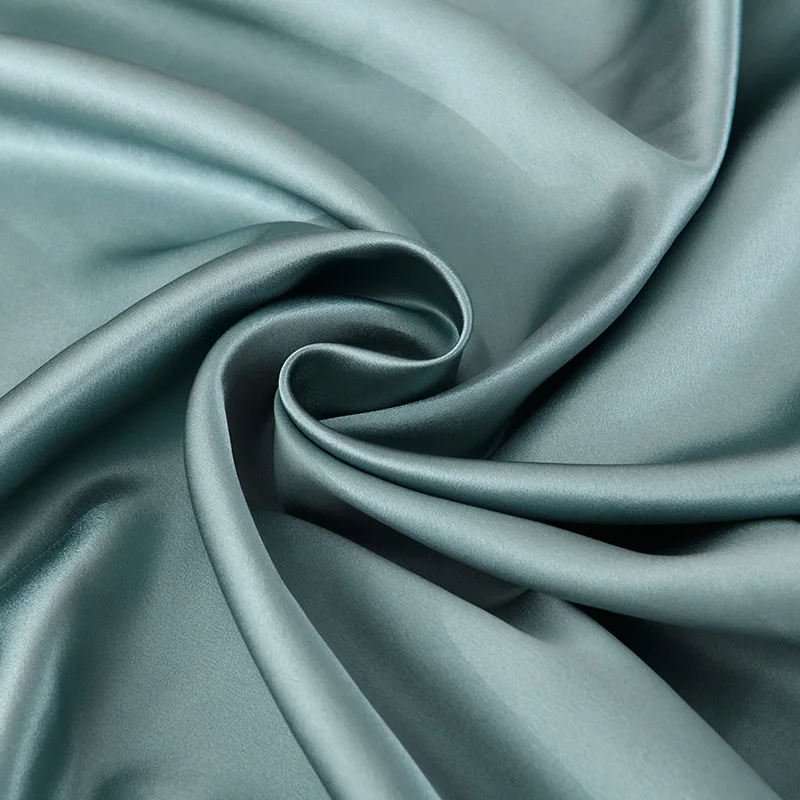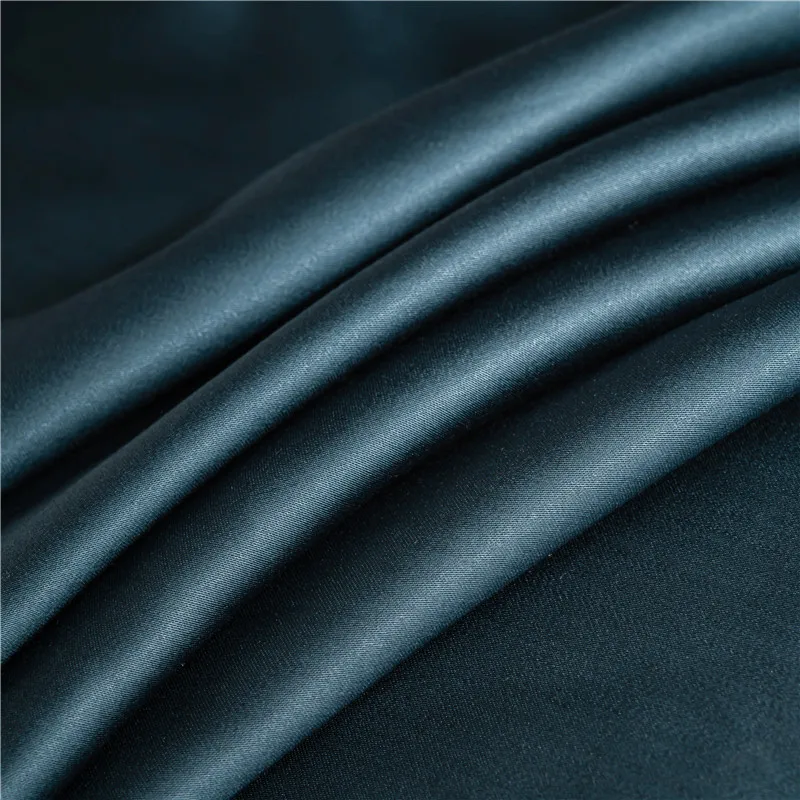Introduction: The Delicacy of Silk Sheets
Silk sheets represent the pinnacle of luxury bedding, but their delicate nature demands specific care—especially when it comes to temperature. These premium natural fibers are remarkably sensitive to heat, requiring precise temperature control during washing, drying, and storage to maintain their exquisite qualities.
The ideal washing temperature for silk sheets is cold water below 30°C (86°F). This simple yet critical detail can dramatically impact the longevity of your investment.
Understanding why temperature matters is essential for preserving:
– The natural strength and integrity of silk fibers
– The characteristic luminous sheen that makes silk so desirable
– The smooth, soft feel against your skin
– The overall lifespan of your bedding investment
Premium Mulberry silk bed sheets within the 19-25 momme weight range (indicating quality and durability) are particularly sensitive to temperature changes. Improper heat exposure can reduce silk sheet lifespan by as much as 50%, turning a long-term investment into a short-lived luxury.
For those new to Mulberry silk sheets and their care, understanding temperature requirements is your first step toward enjoying their amazing benefits for years to come.
The Science Behind Silk’s Temperature Sensitivity
Silk’s remarkable properties stem from its unique protein structure, which shares similarities with human hair. Both are made of protein fibers called fibroin, composed of amino acids arranged in specific patterns. This natural composition explains why temperature affects silk so profoundly.
When exposed to high temperatures:
– Protein molecules in silk begin to denature (change structure)
– Hydrogen bonds between protein chains break down
– Natural elasticity diminishes
– Fiber strength decreases substantially
– The characteristic sheen becomes dull
The relationship between silk quality and temperature sensitivity is particularly evident in 100% silk sheets. Higher momme weight silk (19-25 range) contains more silk per square inch, creating a denser fabric that can become even more susceptible to temperature damage due to heat retention within the tightly woven fibers.
Heat damage to silk is cumulative and often irreversible. Each exposure to excessive temperature breaks down the protein structure a little more, gradually diminishing the qualities that make silk exceptional. This scientific reality forms the basis for all temperature recommendations throughout the silk care process.
The Ideal Water Temperature for Washing Silk Sheets
The optimal water temperature for washing silk sheets is cold water below 30°C (86°F), with 20°C (68°F) or cooler being ideal. This temperature range is crucial for preserving silk’s natural properties.
Why cold water is essential:
Cold water preserves silk’s molecular structure, maintaining its natural sheen and elasticity. By contrast, hot water begins breaking down silk proteins, causing irreversible damage including:
– Weakening of fiber strength
– Loss of natural luster
– Increased likelihood of shrinkage
– Accelerated color fading
– Reduction in the smooth hand-feel
Seasonal water temperature adjustments may be necessary, particularly in summer when tap water can run warmer. In these cases, allow water to cool slightly before washing your silk sheets. In winter, extremely cold water (near freezing) isn’t necessary—comfortable cold water is sufficient.
The pH level of your washing solution also interacts with temperature—warmer water accelerates chemical reactions, potentially making detergents more aggressive against silk fibers. This is another reason why choosing Mulberry silk sheets and caring for them properly with cold water is so important for maintaining their quality.
Machine Washing Silk Sheets: Temperature Settings & Process
While hand washing is traditionally recommended, many modern washable silk sheets can withstand gentle machine washing with proper temperature control. Follow these steps for safe machine washing:
Select the appropriate temperature setting: Choose “Cold” (30°C/86°F maximum) or “Cold/Cold” on machines with separate wash/rinse temperature controls.
Choose the correct cycle: Select “Delicate” or “Silk” cycle, which uses gentle agitation and lower spin speeds.
Prepare your silk sheets:
– Turn sheets inside out to protect the surface
– Place in a mesh laundry bag to reduce friction
– Ensure the washing machine is not overloadedAdd minimal detergent: Use less detergent than usual—approximately half the recommended amount for regular loads. Cold water dissolves detergent less efficiently, so less is needed to prevent residue.
Set the spin cycle: Choose the lowest spin speed available (400-600 RPM) to reduce stress on wet silk fibers.
Special considerations for premium silk: Higher momme weight silk (19-25) may benefit from an extra rinse cycle at the same cold temperature to ensure all detergent is removed.
For washing machines without specific temperature settings, the “Cold” setting typically uses water below 30°C (86°F), which is suitable for silk care.
Hand Washing Silk Sheets: Temperature Control Techniques
Hand washing offers the most precise temperature control for silk care. Follow these steps for optimal results:
Prepare your washing basin: Fill with cold water below 30°C (86°F). To test the temperature without a thermometer, use the hand comfort test—the water should feel cool but not uncomfortable to your hand.
Check water temperature: Dip your elbow into the water—it should feel noticeably cool but not painfully cold. This corresponds roughly to 20°C (68°F), which is ideal for silk care.
Add appropriate detergent: Mix a small amount of silk-specific or pH-neutral detergent into the water before adding sheets.
Submerge and clean gently:
– Completely submerge sheets in the prepared water
– Swish gently for 2-3 minutes using light hand movements
– Avoid rubbing, twisting, or scrubbing motionsRinse thoroughly: Use clean, cold water of the same temperature for rinsing. Temperature consistency between wash and rinse prevents shock to the fibers.
Remove excess water: Press sheets between clean towels to absorb moisture. Never wring silk sheets as this damages the wet fibers.
Hand washing is particularly beneficial for premium quality silk, as it provides complete control over water temperature and gentleness, helping maintain the natural temperature regulating silk bedding properties.

Selecting Temperature-Appropriate Detergents for Silk
The relationship between water temperature and detergent performance is crucial for silk care. Cold water washing requires specific detergent considerations:
| Recommended Detergents | Harmful Detergents |
|---|---|
| pH-neutral liquid detergents | Enzyme-containing detergents |
| Silk-specific cleaners | Bleach-containing products |
| Gentle wool detergents | Optical brighteners |
| Baby shampoo (diluted) | Heavy fragranced detergents |
| Cold-water formulated detergents | Powdered detergents (dissolve poorly in cold) |
In cold water, detergent molecules move more slowly and dissolve less efficiently. This actually benefits silk care, as it creates a gentler washing environment. However, it also means residue can remain if using too much detergent or improper types.
Cold water washing requires detergents that:
– Dissolve completely at low temperatures
– Contain no enzymes (which can break down silk proteins)
– Have a neutral pH (ideally 7.0-7.5)
– Are free of optical brighteners that can change silk’s appearance
Using the correct detergent at cold temperatures helps preserve the skin benefits of mulberry silk bedding by maintaining the fabric’s natural properties and ensuring no irritating residues remain.
Drying Temperatures for Silk Sheets: Best Practices
Drying temperature is just as critical as washing temperature for preserving silk quality. Excessive heat during drying can cause more damage than improper washing temperatures.
Optimal air drying conditions:
– Ambient room temperature: 65-75°F (18-24°C)
– Humidity level: 40-60% (not too humid or too dry)
– Air circulation: Gentle, indirect air flow
– Light exposure: No direct sunlight (causes temperature spikes)
Proper positioning techniques:
– Lay flat on a clean, dry white towel
– Reshape gently while damp
– Flip occasionally to ensure even drying
– Keep away from heating vents, radiators, and sunny windows
If machine drying is absolutely necessary (check manufacturer’s guidelines first), use these parameters:
– Temperature setting: Air-dry or no heat setting only
– Time: Minimum time needed (15-20 minutes maximum)
– Cycle: Delicate or air fluff
– Load: Very small loads only
Watch for these warning signs of heat damage during drying:
– Stiffening of the fabric
– Loss of natural sheen
– Wrinkling that doesn’t relax
– Shrinkage or dimension changes
Silk fitted sheets require particular attention during drying, as improper temperature can affect their elasticity and fit. Always err on the side of caution—slightly damp silk can finish air drying on the bed rather than risking heat damage.
Temperature Considerations for Ironing Silk Sheets
Ironing silk requires careful temperature control to smooth wrinkles without damaging fibers. The maximum safe iron temperature for silk is 150°F (65°C), which corresponds to the “Silk” or “Low” setting on most irons.
Safe ironing techniques:
Test iron temperature first: Before touching the iron to your sheets, test on an inconspicuous corner or hem. The iron should feel warm, not hot.
Use protection: Place a clean cotton cloth between the iron and silk to create a buffer against direct heat.
Keep the iron moving: Never let the iron rest in one spot, even for a few seconds.
Iron while slightly damp: Slightly damp silk responds better to low-temperature ironing.
Alternative wrinkle removal methods:
- Hanging in a steamy bathroom (65-75°F/18-24°C with steam)
- Using a handheld steamer 6-8 inches away from fabric
- Smoothing by hand while damp and laying flat to dry
For silk flat sheets with persistent wrinkles, consider using the silk setting on a steamer rather than direct ironing. The diffused heat relaxes fibers without direct contact.

Seasonal Temperature Adjustments for Silk Care
Silk care requires subtle adjustments based on seasonal temperature variations:
Winter considerations:
– Allow very cold tap water to warm slightly to about 60°F (15°C) before washing
– Dry indoors at room temperature, away from heaters
– Compensate for dry winter air by using slightly less detergent
– Allow longer drying times due to higher indoor humidity
Summer adjustments:
– Use the coldest water setting available, as summer tap water often runs warmer
– Consider adding ice cubes to washing basin to maintain optimal temperature
– Dry in air-conditioned environments rather than outdoors
– Be vigilant about keeping silk away from direct sunlight, which can raise fabric temperature to damaging levels
Humidity factors:
Humidity works in conjunction with temperature to affect silk. High humidity with high temperature accelerates damage, while moderate humidity (40-60%) helps silk maintain proper moisture content.
These seasonal adjustments help maintain consistent care quality year-round, ensuring your sheets continue to regulate sleep temperature effectively regardless of the season.
Storage Temperature Requirements for Silk Sheets
Proper storage temperature is often overlooked but essential for maintaining silk quality between uses. The ideal storage environment for silk sheets should be:
- Temperature: 60-75°F (15-24°C)
- Humidity: 40-60% relative humidity
- Stability: Minimal temperature fluctuations
Why temperature stability matters:
Fluctuating temperatures cause silk fibers to expand and contract, gradually weakening the fabric structure. Consistently high storage temperatures accelerate the breakdown of proteins in silk, while very cold temperatures can make silk brittle if the humidity is also low.
Creating ideal storage conditions:
– Store in breathable cotton storage bags rather than plastic
– Place in closets or drawers away from exterior walls
– Keep away from attics, basements, and garages where temperatures vary widely
– Add cedar blocks rather than mothballs (which require ventilation)
– Ensure sheets are completely dry before storing
For long-term storage, periodically air out silk sheets in room-temperature environments to release trapped moisture and refresh the fibers.
How Temperature Affects Different Silk Varieties
Different silk varieties exhibit varying degrees of temperature sensitivity:
Mulberry Silk (19-25 momme):
The gold standard for silk bedding, cultivated Mulberry silk has excellent temperature tolerance when properly cared for, but its fine fibers require strict adherence to cold water washing and low-heat drying.
Tussah (Wild) Silk:
More textured and naturally stronger, wild silk can tolerate slightly higher washing temperatures (still under 30°C/86°F) but remains vulnerable to drying heat.
Charmeuse Silk:
This weaving technique creates a fabric with different textures on each side, making temperature control crucial to maintain the characteristic sheen of the smooth side.
Silk Blends:
Fabrics blending silk with cotton or synthetic fibers may withstand slightly higher temperatures, but should still be washed in cold water to preserve the silk component.
Momme Weight Considerations:
Higher momme weight queen size silk sheets (22-25 momme) contain more silk per square inch, making them more durable but also potentially more heat-retentive during drying. The increased density means they may take longer to dry at safe temperatures.
Identifying your specific silk type is essential for fine-tuning temperature care for optimal results.
California King Silk Fitted Sheet, King Size Silk Fitted Sheet, Mulberry Silk Fitted Sheet, Queen Size Silk Fitted Sheet
Price range: $120.04 through $390.79 Select options This product has multiple variants. The options may be chosen on the product pageFull-size Silk Sheets, King Size Silk Sheets, Queen Size Silk Sheets, Twin Size Silk Sheets, Washable Silk Sheets
Price range: $95.95 through $178.37 Select options This product has multiple variants. The options may be chosen on the product page100% Silk Sheets, Green Silk Sheets, King Size Silk Bedding Set, Mulberry Silk Bedding Sets, Queen Size Silk Bedding Set
Price range: $1,246.21 through $1,615.22 Select options This product has multiple variants. The options may be chosen on the product pageEucalyptus Silk Bedding Sets, Eucalyptus Silk Sheets
Price range: $360.24 through $393.60 Select options This product has multiple variants. The options may be chosen on the product page- Price range: $267.82 through $306.55 Select options This product has multiple variants. The options may be chosen on the product page
King Size Silk Fitted Sheet, Queen Size Silk Fitted Sheet, Twin Silk Fitted Sheet
Price range: $113.28 through $145.58 Select options This product has multiple variants. The options may be chosen on the product page
Common Temperature-Related Mistakes and Their Impact
Understanding the consequences of temperature mistakes helps reinforce proper care habits:
Hot Water Washing:
Using water above 30°C (86°F) causes immediate protein degradation in silk fibers. The damage appears as reduced sheen, stiffening of the fabric, and potential shrinkage of 5-8% after just one hot wash.
High Heat Drying:
Tumble drying with heat or placing silk in direct sunlight causes more severe damage than hot water washing. The direct heat rapidly breaks down protein bonds, resulting in brittle fibers and permanent loss of silk’s characteristic drape and feel.
Ironing Errors:
Using the cotton setting instead of silk setting on an iron can raise the temperature to 400°F (204°C), more than three times the safe maximum for silk. This extreme heat literally cooks the protein fibers, causing immediate visible damage including scorching and permanent stiffness.
Incorrect Seasonal Storage:
Storing silk sheets in attics or similar spaces where summer temperatures can exceed 100°F (38°C) accelerates aging and yellowing. Three months of improper storage can cause as much damage as years of normal use.

FAQs: Temperature Questions About Silk Sheet Care
Is cold water always best for silk washing?
Yes, cold water below 30°C (86°F) is always best for silk. Unlike some fabrics that benefit from occasional hot washing, silk never requires warm or hot water for cleaning effectiveness.
What’s the absolute maximum safe temperature for washing silk?
The absolute maximum safe temperature is 30°C (86°F), but staying closer to 20°C (68°F) provides a better margin of safety and preserves silk quality longer.
How can I tell if I’ve damaged my silk with high temperatures?
Temperature damage appears as a loss of natural sheen, stiffening of the fabric, visible shrinkage, color changes, or a rough texture. The damage is cumulative and often becomes more noticeable after multiple improper temperature exposures.
Can silk sheets go in the dryer at any temperature?
Most silk sheets should not go in the dryer at all. If the manufacturer specifically states the sheets are dryer-safe, only use an air-dry or no-heat setting with a very short cycle time.
What’s more damaging: hot water washing or hot air drying?
Hot air drying typically causes more severe damage than hot water washing because the direct, concentrated heat affects already vulnerable wet silk fibers and can raise the fabric temperature higher than hot water washing.
Do different silk colors have different temperature sensitivities?
Yes, darker colored silks are generally more temperature sensitive than lighter colors. Dyes can affect the protein structure of silk, sometimes making colored silk slightly more vulnerable to heat damage than undyed or lightly dyed silk.
Expert Temperature Tips for Extending Silk Sheet Lifespan
Pre-cool your washing basin by adding a few ice cubes to tap water in summer months when water runs warmer.
Monitor actual water temperature with an inexpensive kitchen thermometer for the first few washes until you develop a feel for proper temperature.
Gradually acclimate silk when moving between temperature extremes. For example, don’t take sheets directly from a cold washing basin into a warm room for drying.
Rotate silk sheets seasonally rather than washing the same set repeatedly, giving fibers time to fully recover between uses and washes.
Refresh lightly used silk by hanging in a steamy bathroom rather than full washing, reducing temperature exposure.
Create a dedicated silk washing kit with appropriate detergent and temperature testing tools to ensure consistent care.
Restore minor heat damage by lightly misting with distilled water and allowing to air dry flat, which can help relaxed stressed fibers.
These techniques represent professional-level silk care practices that maintain the temperature sensitivity of luxury silk while extending its useful lifespan considerably.
Temperature Considerations for Vegan Silk Alternatives
For those seeking ethical alternatives, vegan silk bedding offers similar luxury with somewhat different temperature care requirements:
Plant-based silk alternatives (lyocell, bamboo, etc.) generally have greater temperature tolerance than animal silk, but still benefit from cold water washing below 30°C (86°F). They can typically withstand slightly higher drying temperatures, though air drying remains preferable.
Synthetic silk alternatives like polyester-based fabrics have the highest temperature tolerance, sometimes allowing for warm washing and low-heat drying. However, treating these materials with the same temperature care as natural silk will extend their lifespan and maintain their silk-like qualities longer.
The environmental benefits of cold-water washing extend across all bedding types:
– Reduced energy consumption
– Lower carbon footprint
– Less fiber shedding into waterways
– Extended fabric lifespan
While vegan alternatives may have different molecular structures than protein-based silk, the temperature care principles remain similar: gentler temperatures preserve the material’s best qualities and provide the longest useful life.
At Sanctuary Soft, we believe that whether you choose traditional mulberry silk or modern vegan alternatives, understanding proper temperature care ensures you’ll enjoy your luxury bedding investment for years to come.







